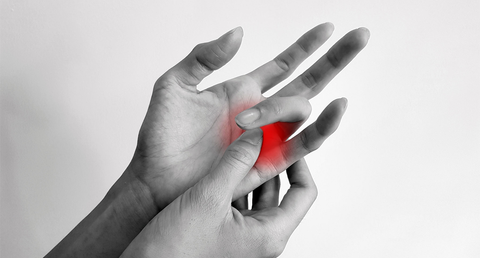Trigger Finger: It’s Not What It Sounds Like (& You Probably Have It)
- Hand Pain
- Pain Relief
- Trigger Finger

Every year, around 2% of the population wake in the morning to finger pain and stiffness so severe, bending the finger at all results in extreme pain. If you’re one of them, you know that finger pain is not only annoying, but can be debilitating. Chores, like washing dishes or preparing dinner, become impossible. Work-related activities such as typing become painful.

And even the things you do for fun - gaming, playing sports or music, or even mindlessly scrolling your phone - become so uncomfortable they’re no longer relaxing.
It might be a minor pain, but it packs a big punch.
If this sounds familiar, you could suffer from a condition called Trigger Finger. And GOOD NEWS, we’re here to help.
Trigger Finger is caused when the tendon in the finger, or the sheath surrounding the tendon, becomes inflamed. Essentially, your hand works as it does because several flexor tendons reach from the forearm to each of the fingers, allowing you to extend and close each finger with ease.

In a normal non-triggered finger, the tendon glides back and forth in the sheath when you open and close your finger. Once the tendon is inflamed, however, that gliding motion becomes difficult (or even stops altogether). This can cause the tendon to lock, or pop as the finger is extended. This resulting painful condition is what’s known as Trigger Finger.
Most commonly, trigger finger occurs in the ring finger or the thumb. It is sometimes known by the more impressive-sounding name stenosing tenosynovitis.
Trigger Finger tends to appear in people who have repetitive motion in their work or hobbies. It affects musicians, maintenance or factory workers, gamers, and typists or those with computer-heavy jobs. It can also affect those with related inflammatory conditions, like carpal tunnel or arthritis. And, sorry ladies, it does tend to occur more often in women (and doubly so for pregnant or postpartum folks). It tends to appear quickly, and can get worse if left untreated.
Happily, treatment for trigger finger is relatively simple and can often be done at home.

Rest, and gentle exercises can relieve pain. Compression gloves can keep inflammation from getting worse. Icing or splinting the finger can help reduce pain and inflammation, and over-the-counter medication can be used when the pain is keeping you from completing work or living life. If the pain persists, or returns, alternative options - like steroid injections or even surgery - can be explored.
At the end of the day, it is helpful to know you are not alone. Trigger Finger is a condition that affects 2-3% of the population (and up to 10% for diabetics). Luckily, there is plenty you can do to help repair your finger and reduce pain, and most of this can be done affordably and from the comfort of home.
You don’t deserve to live in pain. Now that you know what trigger finger is, you are well on your way to finding an effective treatment to get you back to doing the things you love.
Click here for more information on treating trigger finger. For even more information, view the full series here.
Written by: Jess Krzyczkowski
Medically Reviewed By: Dr. Ben Frederick
Continue Reading
View All
Our New Copper Infused Elbow Sleeve
We are so excited to introduce our new Copper Elbow Sleeve. Watch this short video to learn why this is the best cho...
- Joint Pain
- Pain Relief
31 Reasons to Make Compression Gloves Your Soulmate
If you have hand pain, your soulmate might be a pair of compression gloves. Support, compression, copper compression ...
- Arthritis
- Carpal Tunnel
- Hand Pain
- Pain Relief
How to Fight Carpal Tunnel (and Win!)
Carpal Tunnel Syndrome is a painful condition that causes numbness, weakness, and pain in the hands and wrists. There...
- Carpal Tunnel
- Hand Pain
- Pain Relief